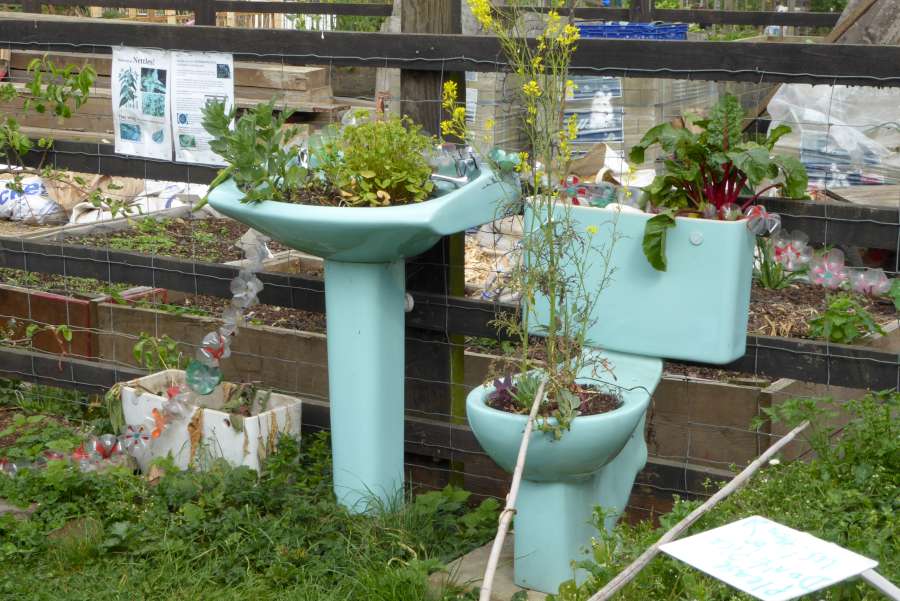There is a reason that garden therapy is so successful. Apart from plants not judging you and a few other benefits, it's the reassuring aspect of time: you can't rush a plant into growing. You need time to really learn about gardening and plants. And whatever way the world goes (safe the total apocalypse perhaps) spring will follow winter, bringing rebirth and a new beginning. It's this reassuring cycle of life played out in a sort of time-lapse before our eyes (at least compared to our own life cycles) I believe, that gives us hope. Also, you can see that in most cases your love and attention pays back, you can make a difference in your garden. And one of the best aspects - at least from a harassed mother's point of view - plants don't talk back at you! (Well, just saying...)
Over the past two years I've mention a few of the things that - aside from actual pottering around in the garden - help lift my spirits in times of need. Like going to Kew or coming across a positive local initiative. But there are more mundane ways, of course, easier to incorporate into everyday life. Right now, I get a lot of pleasure out of the simple fact that bumblebees have chosen to nest in my little garden this year - something you can't force nor even do much to encourage, apparently. One of my recent reads has been No Nettles Required - The Truth about Wildlife Gardening by Ken Thompson whose wonderful book The Sceptical Gardener I've reviewed here before.
No Nettles Required was first published in 2006 and is the result of an in-depth study of wildlife in urban gardens (Sheffield gardens, to be precise) Thompson and his colleagues undertook. The primary aim of that study was to find out what gardens where best suited to encourage wildlife - backed by scientific evidence rather than common lore and long-held traditional wisdom. It's a very interesting read indeed which I can wholeheartedly recommend. But to come back to the bumblebees: Having tried in various ways - like providing nest boxes designed specifically for them - to encourage bumblebees to nest in the wide range of gardens taking part in the study, Thompson's conclusion was this:
Persuading bumblebees to nest in your garden is possible, but like any good estate agent, you need to know what your customers are looking for. My experience confirms that you need not only the right nest but also the right location, and even then you need to be lucky. If your garden is quite flat, this probably means creating some kind of earth bank.
Well, my garden is flat and I've not even provided any extra encouragement apart from stuffing it to the rafters with plants and trying to keep a shallow bowl of water topped up. Yet here they are, nesting somewhere in a hole at the bottom of the boundary wall or the ivy growing on it. And I feel incredibly lucky and happy about it. Even my kids are excited to see the huge bumblebee queen and the smaller worker bumblebees disappear and re-emerge. And quite an impressive sight it is - every time anew boggling our minds that such an "non-aerodynamic bee-ing" can fly. As the saying goes: "According to science the bumblebee should not be able to even lift off - luckily it hasn't read the textbook..."
Another source of joy, mental diversion and optimism is the birds again. Whilst Mrs Wren has not to deigned to grace the nest Mr Wren built in our garden with her eggs (male wrens build several and the female then chooses) we've seen him recently doing improvements, perhaps with a view to a second brood. But for weeks now we've regularly seen a family of tits, the chicks staying with us and creating an enormous racket every time the adults appear, and last night for the first time this year we've seen a fledgling blackbird again. Daddy blackbird is now as curious and almost tame as any Red Robin I've seen.
Yes, I do talk to "our" birds. And I don't mind embarrassing myself by admitting it. Because you know what? That male blackbird now comes to briefly sit less than a metre from me whilst I sit outside typing, eyeing me and listening after I called him over from the fence. And soppy as this may be, it certainly lifts my mood that a wild animal, i.e. not a pet, chooses to be that friendly.
Just yesterday, I delighted in a small piece of planting in what you could call the front garden of a church on Kingsland Road (London). I had walked past it several times over the past months but never really noticed. On Monday, the flowers of a white delphinium caught my eye in passing and made me stop and turn and have a better look. And suddenly I found this bed with a lovely combination of plants in green and white, mainly for dappled shade. It is exactly the style of planting I would most want for my own garden and hence it put a smile on my face.
So here's my advice: keep your eyes peeled for the little everyday pleasures and signs of hope and beauty - they exist almost everywhere. Hardly revolutionary advice, I know, but when everything looks glum we tend to forget. If you make an effort to look out for them and actually want to lift your mood though, these things can definitely give you a boost. For me at least, they rarely fail to deliver. I hope they do the trick for you, too.





 RSS Feed
RSS Feed